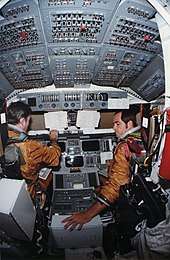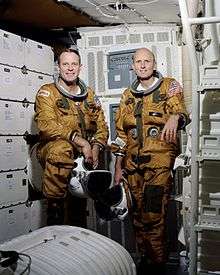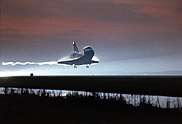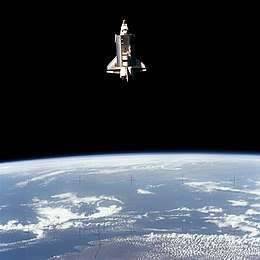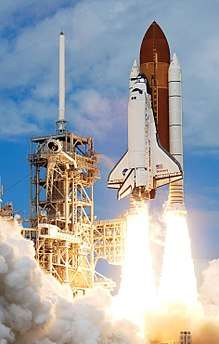Shuttle Ejection Escape Suit
The Shuttle Ejection Escape Suit used from STS-1 (1981) to STS-4 (1982) by a two-man crew used in conjunction with the then-installed ejection seats. It allowed ejections up to Mach 2.7 and 24.4 km (80,000 ft).[1] The suit was manufactured by the David Clark Company of Worcester, Massachusetts. It was derived from the USAF Model S1030 suit, which at the time, was being worn by SR-71 pilots.[1] Both the ejection suits and ejection seats were removed after the Shuttle became certified.[1]
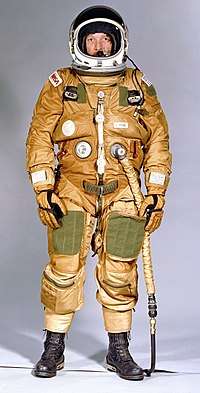
Shuttle Ejection Escape Suit
Specifications
- Name: Shuttle Ejection Escape Suit (S1030A)[2][1]
- Derived from: USAF Model S1030[2][1]
- Manufacturer: David Clark Company[2]
- Missions: STS-1 to STS-4[1]
- Function: Intra-vehicular activity (IVA) and Ejection[2]
- Operating Pressure: 2.7 psi (18.6 kPa)[2]
- Suit Weight: 40 lb (18 kg)[2]
- Primary Life Support: Vehicle Provided[2]
- Backup Life Support: Vehicle Provided[2]
Images
gollark: I mean, there's no evidence of rainbow formation through this "peace and love" thing, but you can easily make rainbow-type patterns with a regular prism, or even just some plastic rulers.
gollark: I think the specialized optics would work better.
gollark: What's a "peace and love"? How do you recreate that in the lab?
gollark: Using specialized optics in some cases, or mist generation to recreate normal rainbow formation conditions.
gollark: There is actually research into artificial rainbow generation at small scales.
References
| Wikimedia Commons has media related to Shuttle Ejection Escape Suit. |
- Daniel M.Barry and John W. Bassick (July 1995). "25th International Conference on Environmental Systems: NASA Space Shuttle Advanced Crew Escape Suit Development". San Diego, California: David Clark Company/SAE International. Retrieved 6 October 2014.
- Kenneth S. Thomas & Harold J. McMann (2006). US Spacesuits. Chichester, UK: Praxis Publishing Ltd. p. 374. ISBN 0-387-27919-9.
- Kenneth S. Thomas & Harold J. McMann (2006). US Spacesuits. Chichester, UK: Praxis Publishing Ltd. pp. 38, 368. ISBN 0-387-27919-9.
This article is issued from Wikipedia. The text is licensed under Creative Commons - Attribution - Sharealike. Additional terms may apply for the media files.
